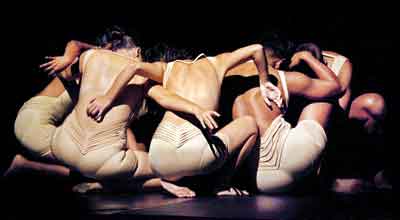A bold take on seven

Dancers interlocking with each other. Pix by Priyantha Wickramaarachchi
In Colombo, the contemporary/post-modern dance genre has seen choreographers like Venuri Perera or Kapila Palihawadana and his Ntanda troupe produce some stunning work which push the boundaries of performance and challenge what can be considered dance. Educated at Denison University and a talented choreographer herself, Umeshi Rajeendra launched the Mesh Academy of Dance in 2015. In April this year, with the creation of her own experimental dance company Mesh Dance Theatre, she successfully held her first show ‘Deconstruct the Embody’ which used an art gallery as a performance space in which to move audiences around the performers and the choreography.
The company’s most recent show – ‘Seven – The Seeker, The Thinker’ – reverted back to traditional staging, using the University of Visual and Performing Arts theatre. Though a slightly odd theme, using the number seven as a springboard to create choreography becomes nonetheless intriguing when you realize how deeply embedded seven is in our history and culture.
Beginning with a voice over of the ‘Poem Seven’ by Ed Kastro, a single male dancer onstage (Pathum Dharmarathne) used his body to respond to the words in the poem, flailing his arms and his legs and exploring each limb’s movement. Postmodern dancing is often defined by its ability to turn everyday movement into choreographic performance. Watching the introduction I was reminded of ‘Can We Talk About This’ – a fascinating collection of pieces by Lloyd Newson and DV8 (a physical theatre company based in the UK) – which utilised stories and poems to produce choreography. Much like ‘Can We Talk About This’, the ‘Poem of Seven’ set the stage for something promising.
What was exciting to note was that the majority of the performance was scored by Natasha Senanayake. Judging by her musical direction for previous shows, Senanayake has always had that innate ability of completely understanding the vision of the show and guiding the music in accordance with the actors/singers/dancers.
The first piece, ‘Zayin’ (the seventh letter in the Hebrew alphabet), explores the range of sinful human attitudes and its effect on how a human being changes over time. Beginning with a solitary body onstage that does not face the audience and is coated in green light, the lights flip to a warm wash to reveal she is surrounded by multiple bodies. This changeover occurs multiple times – a possible commentary on loneliness? That interpretation is flipped on its head when menacing electronic music and skittery violins accompany the circle’s subsequent movement around the lonely figure. With costumes that had low-cut backs, harsh lighting, and the sounds of a female harmonizing over the music, the dancer’s spines moved delicately as they seemed to unlock each part of their body and circle around her. I wondered whether this was an allusion to her mental deterioration at the hands of her inner conscience.
It was certainly a heavy piece to wrap your head around but you never gave up questioning what each sequence could mean. In partners the dancers engaged in contact improvisation (a form of choreography which explores the fundamentals of touch and shifting weight onto each other’s bodies). The contact improv seemed to emphasise themes of sexuality and lust as they touched their bodies suggestively. At another particular moment, the lead dancer repeated a sequence of movements which became more and more erratic (reminiscent of Keersmaerker’s seminal ‘Rosa Danst Rosas’ piece) and it was fascinating to see how basic everyday movement could turn into a piece of choreography. Having said that, I think there was a tendency in spare moments to rely on undulating, which meant it became a bit too overused.
It was almost a relief for ‘Zayin’ to flow into ‘Forward Motion’ which explored Pluto’s seven principle directions of motion. Set to Max Richter’s reworked arrangement of Vivaldi’s ‘Four Seasons’ it provided just the right calming and ebullient atmosphere that seemed to take the weight off of what we had just seen before. Perhaps more traditionally influenced than the other two dances, it was enthralling to watch their bodies play with levels and move in motion to such an uplifting score.
The final piece ‘Seven in One’ is what Umeshi wanted to symbolize as an exploration of the number seven in all its aspects; ‘an exploration of the human body as a visual element devoid of narrative or representation’. Dressed in baggy red tops and black shorts and shaking their bodies to tabla-led music with voices echoing the number ‘7’ in different languages, the main thing I got from this dance was an overflow of joy. Erratic, yes, but it felt like the dancers properly let loose, letting their bodies lead them rather than them controlling it. Being the final piece of the show there was an element of fatigue present on the stage – the whoops felt slightly forced rather than being something the dancers committed to. The main thing I could take from that piece was how the cast of dancers worked together right till the very end. It was humbling to watch.
I enjoyed ‘Forward Motion’ the most but I don’t know whether that was partially because it was more traditional choreography than what was perhaps devised in other dances. Overall, though each piece was individual and remarkable in its own right, it did not perhaps flow as coherently into one another as one would have liked.
It was clear that everyone’s technique wasn’t always on par with the others but the show definitely played into the fundamentals of postmodern dancing – there doesn’t need to be a certain level reached to participate in dancing or be considered a dancer. A controversial statement but when the performance is this intriguing and this exciting, why argue?


